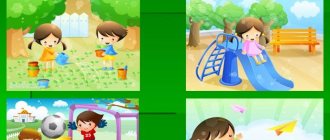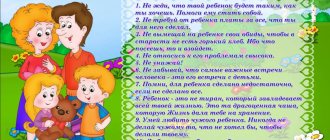Statistics
According to the Russian Ministry of Internal Affairs, in January–July 2016, 8.1 thousand people died in road accidents.
In these road accidents, 254 children died and more than 8,000 children were injured. According to experts, the cause of road accidents is drivers ignoring traffic rules. However, responsibility for road safety also lies with pedestrians, including parents of preschool children. The younger the child, the less sensitive he is to danger; the baby does not always know and understand what exactly threatens him, what consequences this or that behavior may entail. That is why it is very important for mothers, fathers, and other close adults to pay increased attention to the safety of children, and teachers should promptly inform parents about methods and means of preventing accidents. One of the forms of work in this direction is consultation for parents in kindergarten on traffic rules.
The success of speaking to parents of students depends on how the teacher prepares for the consultation, whether he can interest the audience and draw attention to the problem. Preparation of the consultation begins with studying the age characteristics of preschoolers from the point of view of children’s perception of the road and moving vehicles.
How kids see and imagine the roadway
A child’s field of vision is narrower than that of an adult, so it is difficult for a preschooler to determine the distance to a rapidly approaching car. Moreover, the child is not able to calculate the speed of traffic.
Children of early, junior and even middle preschool age do not perceive a car as something potentially dangerous. The kid rushes after the ball that has rolled out onto the road, not thinking at all about moving cars. The main thing for the child is to return the toy. He does not understand that trying to catch the ball may be his last. Therefore, the sooner work begins on children learning the rules of the road, the greater the likelihood of saving children from harm. The teacher tells moms and dads about all this, conducting a consultation on traffic rules for parents.
What and how to tell children about traffic rules
Visual-figurative thinking dominates in preschoolers, so a literal interpretation of the Rules of the Road with a large number of abstract theoretical calculations is unacceptable.
In the second younger group, children are told and shown what a street, sidewalk, or one-way road is. Children are also introduced to types of transport (cars and trucks, buses, trolleybuses, trams), and are told about the work of a driver, traffic lights (red and green signals).
Teachers of the middle group introduce children to two-way traffic on the road, yellow traffic lights, traffic controller gestures, the “Pedestrian Crossing” road sign, ground and underground crossings, classification of modes of transport (water, air, land). They explain how to move along the sidewalk (on the right side) and behave in public transport.
In the senior and preparatory groups, students’ ideas about the road (center line) are expanded. Future schoolchildren are shown road signs (“Crossroads”, “Food station”, “Telephone”, “Medical assistance”, “Parking”, “Pedestrian traffic is prohibited”, “Entry is prohibited”, “Public transport stop”), and the rules are reinforced with the children crossing the roadway.
When working with children it is appropriate to:
- personal example;
- visibility (posters, illustrations);
- reading fiction;
- games.
The teacher informs parents about the content of teaching preschoolers on the topic “Road Rules” in a specific age group, offers handouts (memos, brochures, diagrams), and demonstrates presentations. The teacher talks in detail about how to study at home. The listed methods are appropriate and effective when it comes to consulting parents on traffic rules in kindergarten according to the Federal State Educational Standard.
Personal example
When going somewhere with a child, parents:
- holding the baby's hand;
- while leading the baby along the sidewalk, they themselves are closer to the roadway, and the child walks nearby;
- cross the road when the traffic light is green;
- at the intersection, first they look to the left, then to the right, then to the left again, and only after that, if the cars are far away, they go out onto the roadway and calmly, without fuss, head to the opposite side of the street;
- they don’t cross the road because “it’s closer,” even if they’re in a hurry, they don’t climb over barriers;
- do not catch up with the departing bus, trolleybus, tram or minibus;
- when crossing the road after getting out of the vehicle, the bus, trolleybus and minibus go around from behind, and the tram - from the front;
- do not enter the roadway due to an obstacle (vehicle, bush, fence, etc.);
- in the dark, wear reflective elements (flickers) on yourself and your child;
- They talk through the actions being performed and draw the child’s attention to the need to follow traffic rules.
When transporting a child by car:
- drive a car, observing the rules for drivers;
- children are transported in car seats;
- adults and children get into and out of the car only from the sidewalk.
When disembarking from public transport, an adult leaves first. Rules of behavior on the road are drawn up in the form of a list, table, diagram, which should have a name. For example, consultation on traffic rules for parents “Children’s safety is the concern of adults.”
Visibility
Pictures and posters “Pedestrian Reminder”, “Traffic Light”, “Be Attentive!”, “Road ABC”, etc. help children learn the rules of the road. You can buy a ready-made poster or draw it with your child at home.
Visual materials will not be useful if they hang in the room “in the background.” The teacher draws the attention of parents to the need to talk with the child about the content of the picture, poster, discuss what is depicted, whether the character is doing the right thing, and how to behave in such a situation.
Books on traffic rules for preschoolers
for reading to children of primary preschool age :
- B. Zakhoder “Chauffeur”;
- N. Kalinina “How the guys crossed the street”;
- A. Barto “Truck”, etc.
Children four to five years old are read stories by A. Dorokhov from the book “Green, Yellow, Red”, poems by V. Pishumov “Song about Rules”, S. Mikhalkov “Bad History”, V. Kozhevnikov “Traffic Light”, etc.
Pupils of the senior and preparatory groups get acquainted with the working life of S. Mikhalkov’s hero Uncle Styopa, master the gestures of a traffic controller, listening to V. Dorokhov’s story “The Influential Wand” and V. Semerin’s poem “Forbidden - Permitted”, learn to be exemplary pedestrians and responsible passengers.
An important point when working with parents: do not forget to inform them that after reading a book you should discuss its contents with your child.
Traffic rules games for preschoolers
Play is the leading activity in preschool childhood. The full development of the child, the preschooler’s mastery of vital skills and abilities, takes place precisely in it. Here are some examples of games that a teacher can recommend to parents for studying at home.
Younger preschoolers
The purpose of the didactic game “Traffic Light” is to teach children to recognize traffic light signals. A mock-up of a traffic light with empty holes and two sets of circles in red and green are prepared in advance. The adult gives one set to the child, and keeps the other for himself.
The adult inserts one of the circles into the corresponding hole of the model and invites the child to determine which signal is on (the child picks up a circle of the same color), and also explain what the pedestrian should do (red - stand still, green - look around and walk).
Children from 4 to 5 years old
You can also play “Traffic Light” with kids of this age, just add a yellow signal. No less interesting is “Word Game” . An adult offers to clap your hands when words and phrases related to the following are heard:
- to a traffic light (standing at an intersection, standing at home, red light, blue light, yellow light, brown light, helping a pedestrian, hindering a pedestrian);
- to a pedestrian (intersection, crossing, traffic light, body, standing and waiting, steering wheel, sidewalk);
- to the driver (steering wheel, body, wing, rides, motor, flies, wheel, paws, tail);
- to the passenger (bus, trolleybus, pulls up to a stop, bed, stool, stop, shows a ticket).
Senior preschool age
The game “Guess the Sign” will help you consolidate the names and purposes of road signs . An adult places cardboard signs in plain sight and offers to guess the sign based on the description (in random order he talks about the purpose of the signs).
During the consultation, the teacher invites parents to play and takes on the role of facilitator.
Material for the parent corner on traffic rules consultation (senior group) on the topic
WHAT SHOULD AND WHAT SHOULD NOT PARENTS DO WHEN MOVE?
- Don't rush, always cross the road at a measured pace.
- When going out onto the roadway, stop talking - the child must get used to the fact that he needs to concentrate when crossing the road.
- Do not cross the road when the traffic light is red or yellow; only cross when the light is green.
- Cross the road only in places marked with a “Pedestrian Crossing” road sign.
- Get off the bus, trolleybus, taxi first. Otherwise, the child may fall or run out onto the roadway.
- Invite your child to participate in your observations of the situation on the road: show him those cars that are preparing to turn, driving at high speed, etc.
- Do not leave with your child from behind a car or bushes without first inspecting the roads - this is a typical mistake, and children should not be allowed to repeat it.
- Do not allow children to play near roads or on the roadway.
- Be sure to fasten your seat belts in the car; place the child in the safest place: in a special child seat, in the middle or on the right side of the rear seat; During long trips, stop more often: the child needs to move.
- Don't be aggressive towards other road users. Instead, explain to your child specifically what their mistake was. Use different situations to familiarize yourself with the rules of the road, calmly admit your own mistakes.
RECOMMENDATIONS FOR PARENTS
- When leaving home:
- immediately draw the child’s attention to the movement of vehicles at the entrance and together look to see if a car, motorcycle, or bicycle is approaching you;
- If there are vehicles at the entrance or trees growing that block your view, stop your movement and look around to see if there is any danger behind the obstacle.
- When driving on the sidewalk:
- keep to the right side of the sidewalk;
- do not lead the child along the edge of the sidewalk: the adult must be on the side of the roadway;
- hold your baby's hand tightly;
- teach your child, when walking along the sidewalk, to carefully watch the exit from the yard, etc.;
- Explain to your child that throwing stones, glass, etc. at the roadway, or damaging road signs can lead to an accident;
- do not teach your child to go out onto the roadway; carry strollers and sleds with children only on the sidewalk;
- When a group of children moves, teach them to walk in pairs, following all your instructions or those of other adults accompanying the children.
- When preparing to cross the road:
- stop or slow down, inspect the roadway;
- involve your child in monitoring the situation on the road;
- emphasize your movements: turning your head to look around the street, stopping to look at the road, stopping to let cars pass;
- teach your child to recognize approaching vehicles;
- do not stand with your child on the edge of the sidewalk, as when passing the vehicle can get caught, knocked down, or run over with its rear wheels;
- draw the child’s attention to the vehicle preparing to turn, talk about the direction indicator signals of the car and the gestures of the motorcyclist and cyclist;
- repeatedly show your child how the vehicle stops at the crossing, how it moves by inertia.
- When crossing the roadway:
- cross the road only at pedestrian crossings or at intersections along a marked zebra line, otherwise the child will get used to crossing wherever he has to;
- do not rush and do not run; always cross the road at a measured pace;
- do not cross the road diagonally; Emphasize, show and tell your child every time that you are walking strictly across the street, that this is being done for better observation of cars and motorcycles;
- do not rush to cross the road if on the other side you see relatives, friends, acquaintances, or the right bus. Don’t rush and don’t run towards them, instill in your child that this is dangerous;
- do not start crossing a street where traffic rarely passes without looking around;
- Explain to your child that cars can unexpectedly leave the alley or the yard of the house;
- When crossing a roadway at an unregulated crossing in a group of people, teach your child to carefully monitor the start of traffic, otherwise he may get used to imitating the behavior of companions who are not watching the traffic when crossing.
- When boarding and disembarking from public transport:
- go out in front of the child, as the baby may fall, and an older child may run out of the parked vehicle onto the roadway;
- approach the vehicle door only after it has come to a complete stop: a child, like an adult, can trip and get run over;
- do not board public transport at the last moment when it departs (you may be pinned by the doors); The front door is especially dangerous, as you can get under the wheels of a vehicle; teach your child to be attentive in the stopping area - a particularly dangerous place for him: a stationary bus reduces the view of the road in this area, pedestrians here are often in a hurry and can accidentally push the child onto the roadway, etc.
- When waiting for public transport:
- stand with children only on landing areas, and if there are none, on the sidewalk or curb.
- When the car is moving:
- teach your child to sit in the car only in the back seat; do not allow anyone to sit next to the driver unless the front seat is equipped with a special child seat; explain to them that during a sudden stop or collision, the force of inertia “throws” the person sitting forward and he hits the glass of the front panel; this is enough for the passenger to die or be seriously injured;
- Do not allow a small child to stand in the back seat while driving; in the event of a collision or sudden stop, it may fly over the back of the seat and hit the front window or panel;
- Do not allow children to be in the vehicle unattended.
- When traveling on public transport:
- teach your child to hold onto the handrails tightly so that when braking he does not get injured from an impact;
- Explain to your child that you can only get on and off any type of transport when it comes to a complete stop.
“Parent driver, remember!”
Children of preschool and primary school age do not perceive the dangers of transport. They do not yet know what pain and death are. Toys and a ball are much more important to them than life and health. Hence the rule: if a ball rolls out onto the road, a child will definitely appear. Know this and slow down in advance.
If a child looks at a car, this does not mean that he sees it. Carried away by his thoughts, he often does not notice an approaching car. An adult hit by a car suffers a “bumper fracture,” a fracture of the tibia. Children are hit in the stomach, chest and head. As a result, the child dies or receives severe skull injuries, ruptures of internal organs and fractures. The higher the speed of the car, the stronger the impact and the serious consequences!
Psychologist's advice
The preschooler does not understand the danger that awaits him on the street. Therefore, the child should not walk the streets or cross roads on his own. The child has different hearing and vision features. It is difficult for him to determine which direction the sound is coming from. Hearing a car horn, he can take a fatal step towards danger.
The child does not know how to effectively use peripheral vision and completely “turns off” it when running across the road, focusing on any object. He believes that if he sees the driver, then the driver also sees him and will stop. The child cannot determine whether the car is close or far away, whether it is driving fast or slow.
PARENTS SHOULD KNOW THAT...
- Most often, injuries occur due to the fault of adults. Very often, parents themselves violate traffic rules.
- Statistics report that every 16th child injured on the street escaped the hands of the adults accompanying him. When crossing the road with a child, you should hold him tightly.
- Teaching children the rules of the road should not be limited to calls to obey them. Due to the concreteness and figurativeness of children's thinking, learning should be visual and take place in a natural setting. You should use any appropriate moment to clearly and unobtrusively teach your child the rules of behavior on the street, in transport, etc.
- A preschool child should not walk without his parents if vehicles are passing through the yard.
- Parents are required to bring their children to kindergarten and hand them over to teachers.
- On the street, adults should not remain indifferent to the behavior of children who go out for a walk unaccompanied by adults or elders.
WHAT INSIGHTS CAN PARENTS GIVE TO THEIR CHILDREN?
Parents introduce children to the names of the streets they often walk along, the meaning of the road signs they encounter, and remember the rules for driving on the sidewalk and crossing the street (children should understand well that they cannot go out alone, without adults, onto the roadway). Parents can tell their children about the work of a driver, a policeman-traffic controller, and watch with him the work of a traffic light.
SAFETY RULES FOR CHILDREN.
ROAD SAFETY
- You can cross the street only at a pedestrian crossing. They are marked with a special sign “Pedestrian crossing”.
- If there is no underground crossing, you must use a crossing with a traffic light.
- You cannot cross the street at a red light, even if there are no cars.
- When crossing the street, you should always look left first, and when you reach the middle of the road, look right.
- Under no circumstances should you run out onto the road. You have to stop before the road.
- You cannot play on the roadway or on the sidewalk.
- If your parents have forgotten which side to walk around a bus or trolleybus, you can remind them that it is dangerous to walk around these vehicles both in front and behind. You need to go to the nearest pedestrian crossing and cross the street along it.
- It is safest to cross the street with a group of pedestrians.
- Outside populated areas, children are only allowed to walk with adults along the edge (side of the road) towards cars.
DEAR PARENTS!
We are confident that you will support us in our efforts to protect children from the dangers that await them on the road. We believe that you will continue to pay great attention to instilling road safety skills in your child.
We are interested in preserving the life and health of all members of your family, but road safety largely depends on you!
Together we will teach the child to live safely in this world!






